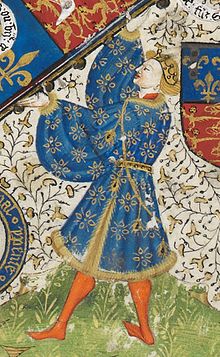This article includes a list of references, related reading, or external links, but its sources remain unclear because it lacks inline citations. (December 2022) |
| Richard of York | |
|---|---|
 Richard of York in the frontispiece of the Talbot Shrewsbury Book, 1445 | |
| Born | 21 September 1411[1] |
| Died | 30 December 1460 (aged 49) Sandal Magna (at the Battle of Wakefield), Yorkshire |
| Burial | 30 July 1476 |
| Spouse | Cecily Neville |
| Issue more... | |
| House | York |
| Father | Richard, Earl of Cambridge |
| Mother | Anne Mortimer |
Richard of York, 3rd Duke of York (21 September 1411 – 30 December 1460), also named Richard Plantagenet, was a leading English magnate and claimant to the throne during the Wars of the Roses. He was a member of the ruling House of Plantagenet by virtue of being a direct male-line descendant of Edmund of Langley, King Edward III's fourth surviving son. However, it was through his mother, Anne Mortimer, a descendant of Edward III's second surviving son, Lionel of Antwerp, that Richard inherited his strongest claim to the throne, as the opposing House of Lancaster was descended from John of Gaunt, Duke of Lancaster, the third surviving son of Edward III. He also inherited vast estates and served in various offices of state in Ireland, France and England, a country he ultimately governed as Lord Protector due to the mental instability of King Henry VI.
Richard's conflicts with Henry's wife, Margaret of Anjou, and other members of Henry's court, such as Edmund Beaufort, 2nd Duke of Somerset, and his competing claim to the throne, were leading factors in the political upheaval of mid-fifteenth-century England, and a major cause of the Wars of the Roses (1455–1487). Richard eventually attempted to take the throne, but was dissuaded, although it was agreed that he would become king on Henry's death. However, within weeks of securing this agreement (the Act of Accord), he was killed at the Battle of Wakefield, alongside his son, Edmund. Two of his surviving sons later ascended the throne: Edward IV and Richard III.